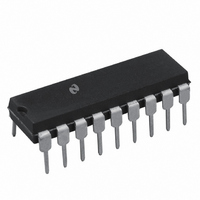LM3915N-1/NOPB National Semiconductor, LM3915N-1/NOPB Datasheet - Page 9

LM3915N-1/NOPB
Manufacturer Part Number
LM3915N-1/NOPB
Description
IC DRIVER DOT BAR DISPLAY 18-DIP
Manufacturer
National Semiconductor
Datasheet
1.LM3915N-1NOPB.pdf
(25 pages)
Specifications of LM3915N-1/NOPB
Display Type
LED, LCD, Vacuum Fluorescent
Configuration
Dot/Bar Display
Digits Or Characters
10 Steps
Current - Supply
6.1mA
Voltage - Supply
3 V ~ 25 V
Operating Temperature
0°C ~ 70°C
Mounting Type
Through Hole
Package / Case
18-DIP (0.300", 7.62mm)
Lead Free Status / RoHS Status
Lead free / RoHS Compliant
Interface
-
Other names
*LM3915N-1
*LM3915N-1/NOPB
LM3915N-1
*LM3915N-1/NOPB
LM3915N-1
Available stocks
Company
Part Number
Manufacturer
Quantity
Price
Part Number:
LM3915N-1/NOPB
Manufacturer:
NS/国半
Quantity:
20 000
Mode Pin Functional Description
DOT OR BAR MODE SELECTION
The voltage at pin 9 is sensed by comparator C1, nominally
referenced to (V
pin 9 is above this level; otherwise it’s in dot mode. The
comparator is designed so that pin 9 can be left open circuit
for dot mode.
Taking into account comparator gain and variation in the
100 mV reference level, pin 9 should be no more than 20 mV
below V
open circuit) for dot mode. In most applications, pin 9 is
either open (dot mode) or tied to V
pin 9 should be connected directly to pin 3. Large currents
drawn from the power supply (LED current, for example)
should not share this path so that large IR drops are avoided.
DOT MODE CARRY
In order for the display to make sense when multiple
LM3915s are cascaded in dot mode, special circuitry has
been included to shut off LED #10 of the first device when
LED #1 of the second device comes on. The connection for
cascading in dot mode has already been described and is
depicted below.
As long as the input signal voltage is below the threshold of
the second LM3915, LED #11 is off. Pin 9 of LM3915 #1 thus
sees effectively an open circuit so the chip is in dot mode. As
soon as the input voltage reaches the threshold of LED #11,
pin 9 of LM3915 #1 is pulled an LED drop (1.5V or more)
below V
referenced 600 mV below V
low, which shuts off output transistor Q2, extinguishing LED
#10.
V
very small current (less than 100 µA) that is diverted from
LED #9 does not noticeably affect its intensity.
An auxiliary current source at pin 1 keeps at least 100 µA
flowing through LED #11 even if the input voltage rises high
enough to extinguish the LED. This ensures that pin 9 of
LM3915 #1 is held low enough to force LED #10 off when
any higher LED is illuminated. While 100 µA does not nor-
mally produce significant LED illumination, it may be notice-
able when using high-efficiency LEDs in a dark environment.
If this is bothersome, the simple cure is to shunt LED #11
with a 10k resistor. The 1V IR drop is more than the 900 mV
(Continued)
LED
is sensed via the 20k resistor connected to pin 11. The
+
LED
for bar mode and more than 200 mV below V
. This condition is sensed by comparator C2,
+
− 100 mV). The chip is in bar mode when
LED
. This forces the output of C2
+
(bar mode). In bar mode,
Cascading LM3915s in Dot Mode
+
(or
9
worst case required to hold off LED #10 yet small enough
that LED #11 does not conduct significantly.
OTHER DEVICE CHARACTERISTICS
The LM3915 is relatively low-powered itself, and since any
number of LEDs can be powered from about 3V, it is a very
efficient display driver. Typical standby supply current (all
LEDs OFF) is 1.6 mA. However, any reference loading adds
4 times that current drain to the V
example, an LM3916 with a 1 mA reference pin load (1.3k)
would supply almost 10 mA to every LED while drawing only
10 mA from its V
drawing less than 10% of the current supplied to the display.
The display driver does not have built-in hysteresis so that
the display does not jump instantly from one LED to the next.
Under rapidly changing signal conditions, this cuts down
high frequency noise and often an annoying flicker. An “over-
lap” is built in so that at no time are all segments completely
off in the dot mode. Generally 1 LED fades in while the other
fades out over a mV or more of range. The change may be
much more rapid between LED #10 of one device and LED
#1 of a second device “chained” to the first.
Application Hints
The most difficult problem occurs when large LED currents
are being drawn, especially in bar graph mode. These cur-
rents flowing out of the ground pin cause voltage drops in
external wiring, and thus errors and oscillations. Bringing the
return wires from signal sources, reference ground and bot-
tom of the resistor string to a single point very near pin 2 is
the best solution.
Long wires from V
oscillations. Depending on the severity of the problem
0.05 µF to 2.2 µF decoupling capacitors from LED anode
common to pin 2 will damp the circuit. If LED anode line
wiring is inaccessible, often similar decoupling from pin 1 to
pin 2 will be sufficient.
If LED turn ON seems slow (bar mode) or several LEDs light
(dot mode), oscillation or excessive noise is usually the
problem. In cases where proper wiring and bypassing fail to
stop oscillations, V
gested limits. Expanded scale meter applications may have
one or both ends of the internal voltage divider terminated at
relatively high value resistors. These high-impedance ends
should be bypassed to pin 2 with at least a 0.001 µF capaci-
tor, or up to 0.1 µF in noisy environments.
+
pin supply. At full-scale, the IC is typically
+
LED
voltage at pin 3 is usually below sug-
to LED anode common can cause
+
(pin 3) supply input. For
www.national.com
00510408













